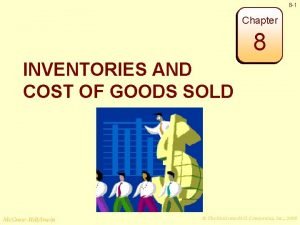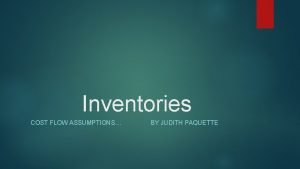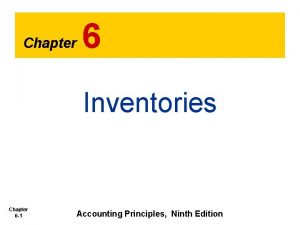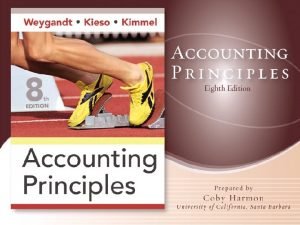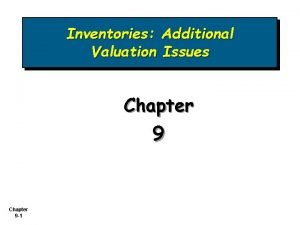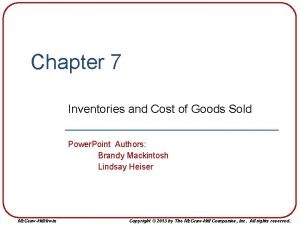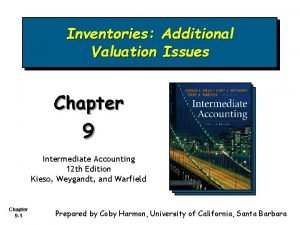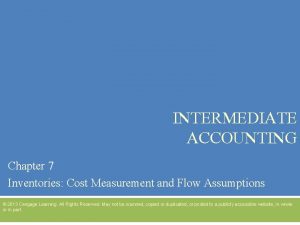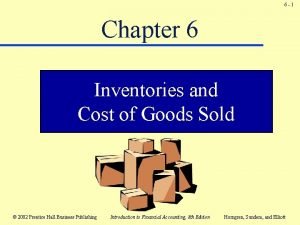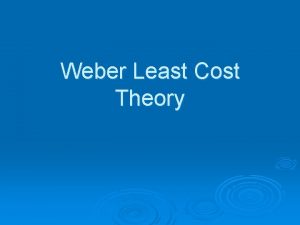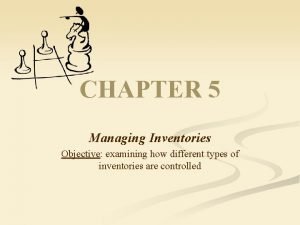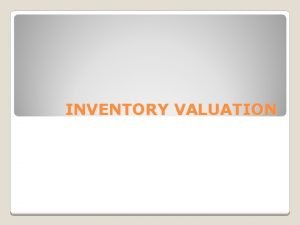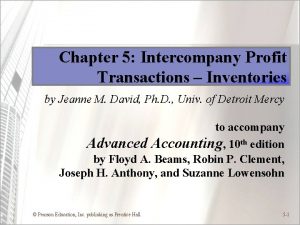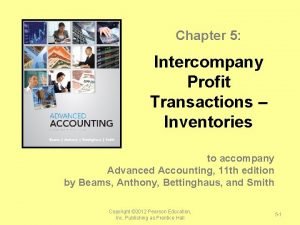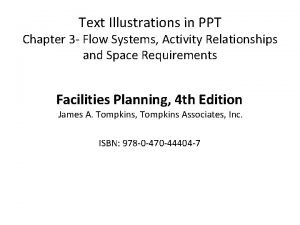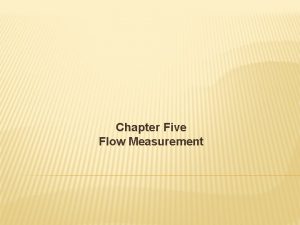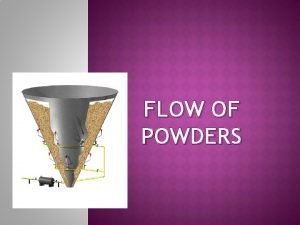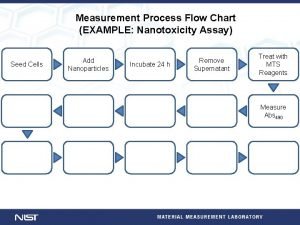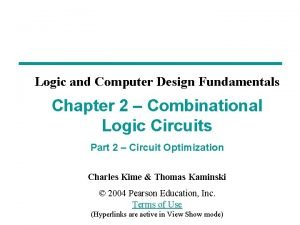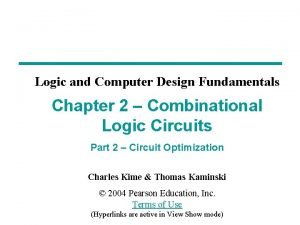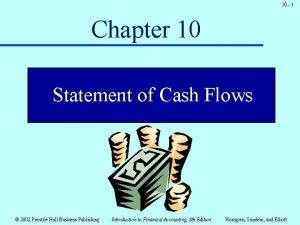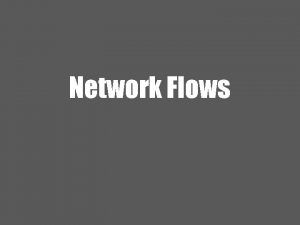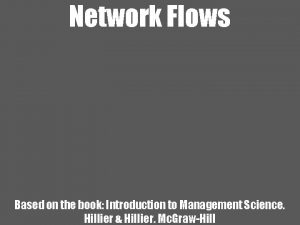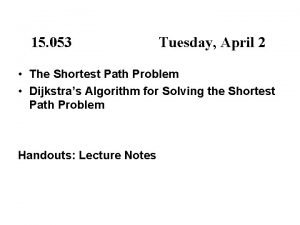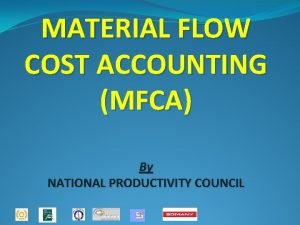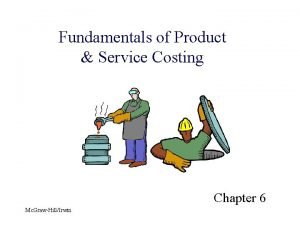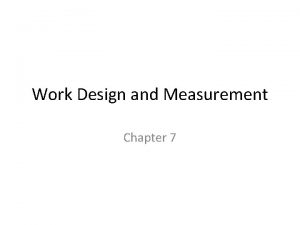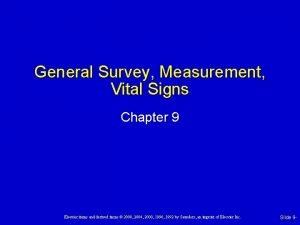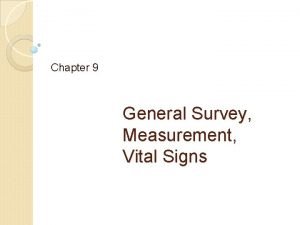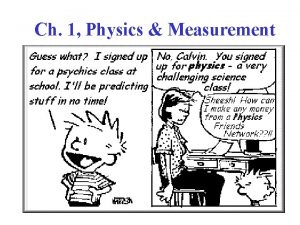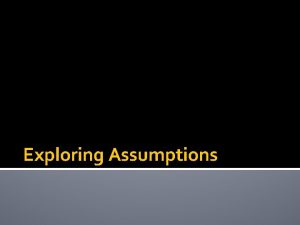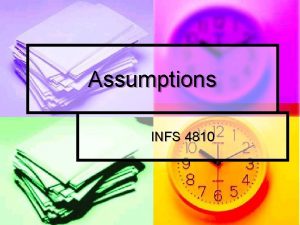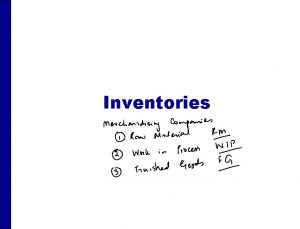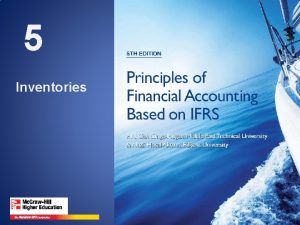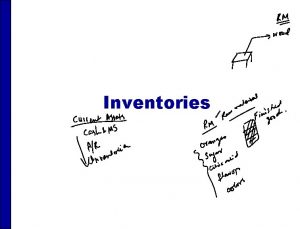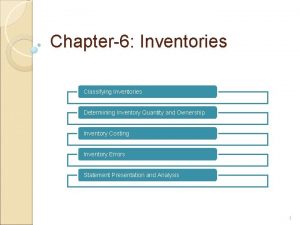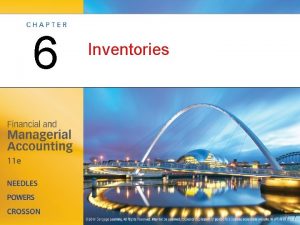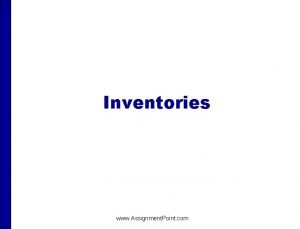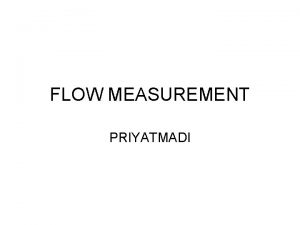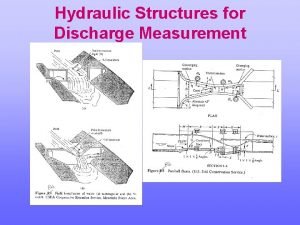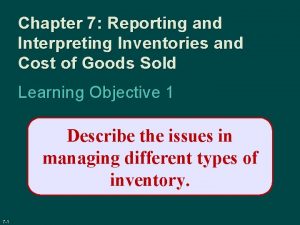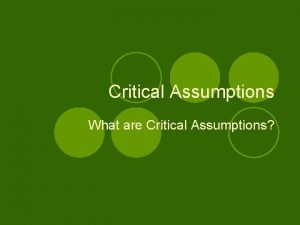Chapter 7 Inventories Cost Measurement and Flow Assumptions



































































- Slides: 67

Chapter 7 Inventories: Cost Measurement and Flow Assumptions An electronic presentation by Douglas Cloud Pepperdine University

Objectives 1. Describe how inventory accounts are classified. 2. Explain the uses of perpetual and periodic inventory systems. 3. Identify how inventory quantities are determined. 4. Determine the cost of inventory. 5. Compute ending inventory and cost of goods sold under specific identification, FIFO, average cost, and LIFO. Continued

3 Objectives 6. Explain the conceptual issues regarding alternative inventory cost flow assumptions. 7. Understand dollar-value LIFO. 8. Explain additional LIFO issues. 9. Understand inventory disclosures. 10. Record foreign currency transactions involving inventory (Appendix).

4 Flow of Inventory Costs Merchandising Company Accounts Payable (or Cash) Goods Purchased Merchandise Inventory Cost of Goods Sold

5 Flow of Inventory Costs Manufacturing Company Accounts Payable (or Cash) Raw Materials Inventory Materials Used in Production Materials Purchased Continued To Goods in Process Inventory

6 Flow of Inventory Costs Manufacturing Company Direct Labor Actual Direct Labor Manufacturing (Factory) Overhead Actual Mfg. Overhead Labor Charged to Production To Goods in Process Inventory Overhead Applied to Production Continued

7 Flow of Inventory Costs Manufacturing Company Goods in Process Inventory Materials Used Direct Labor Overhead Applied Finished Goods Inventory Goods Finished (Manufactured) Goods Sold to Cost of Goods Sold

8 Alternative Inventory Systems A company using a perpetual system maintains a continuous record of the physical quantities in its inventory.

9 Alternative Inventory Systems A company using a periodic system does not maintains a continuous record of the physical quantities on hand.

Computation of Net Purchases + = Purchases Freight-in Purchases Returns and Allowances Purchases Discounts Taken Net Purchases

11 Comparison of Systems Perpetual Inventory System Periodic Inventory System Beginning inventory + Purchases (net) - Goods Sold = Ending Inventory Beginning inventory + Purchases (net) - Ending Inventory = Goods Sold

12 FOB Shipping Point Fruit Express Goods being shipped included in inventory of buyer.

13 FOB Destination Fruit Express Goods being shipped included in inventory of seller.

Determination of Inventory Costs ü Price paid or consideration given ü Freight-in ü Receiving ü Unpacking ü Inspecting ü Storage ü Insurance ü Sales and other applicable taxes

15 Purchases Discounts Under the gross price method, a company records the purchase at the gross price, and records the amount of the discount in the accounting system only if the discount is taken. Under the net price method, a company records the purchase at its net price, and records the amount of the discount in the accounting system only if the discount is not taken.

16 Purchases Discounts A company purchases $1, 000 of goods under terms of 1/10, n/30. Gross Price Method To record the purchase Inventory (or Purchases) Accounts Payable 1, 000

17 Purchases Discounts A company purchases $1, 000 of goods under terms of 1/10, n/30. Gross Price Method To record payment within the discount period: Accounts Payable 1, 000 Purchases Discounts Taken Cash 10 990

18 Purchases Discounts A company purchases $1, 000 of goods under terms of 1/10, n/30. Gross Price Method To record payment after the discount period: Accounts Payable Cash 1, 000 No adjusting entry is required. 1, 000

19 Purchases Discounts A company purchases $1, 000 of goods under terms of 1/10, n/30. Net Price Method To record the purchase: Inventory (or Purchases) Accounts Payable 990

20 Purchases Discounts A company purchases $1, 000 of goods under terms of 1/10, n/30. Net Price Method To record payment within the discount period: Accounts Payable Cash 990

21 Purchases Discounts A company purchases $1, 000 of goods under terms of 1/10, n/30. Net Price Method To record payment after the discount period: Accounts Payable 990 Purchases Discounts Lost 10 Cash 1, 000

22 Purchases Discounts A company purchases $1, 000 of goods under terms of 1/10, n/30. Net Price Method Adjusting entry at the end of period if discount has expired and invoice is unpaid: Purchases Discounts Lost Accounts Payable 10 10

23 Specific Identification Apr. 10 Apr. 20 100 units @ $10 per unit 80 units @ $11 per unit 70 units @ $12 per unit On April 27, sold 90 units from the beginning inventory and 50 units from the April 10 purchase.

24 Specific Identification Ending Inventory Apr. 10 Apr. 20 10 units @ $10 per unit 30 units @ $11 per unit 70 units @ $12 per unit = = = $ 100 330 840 $1, 270 On April 27, sold 90 units from the beginning inventory and 50 units from the April 10 purchase. Beg. Inv. + Purchases - End. Inv. = Cost of Goods Sold $1, 000 + $1, 720 - $1, 270 = $1, 450

25 First-In, First-Out (FIFO) Apr. 10 Apr. 20 100 0 units @ $10 per unit 80 units @ $11 per unit 40 70 units @ $12 per unit Sold 140 units on April 27. Sold all Sold 40 Sold 0

26 First-In, First-Out (FIFO) The ending inventory Apr. 10 Apr. 20 and the cost of goods Ending Inventory sold under perpetual and periodic FIFO are 100 0 units @ $10 per unit = $ 0 identical. = 440 80 units @ $11 per 40 unit 70 units @ $12 per unit = 840 $1, 280 Sold 140 units on April 27. Beg. Inv. + Purchases - End. Inv. = Cost of Goods Sold $1, 000 + $1, 720 - $1, 280 = $1, 440

27 Average Cost Periodic System 100 units @ $10 per unit = $1, 000 = 880 80 units @ $11 per unit 70 units @ $12 per unit = 840 250 units $2, 720 250 units = $10. 88 Sold 140 units during April. $10. 88 x 110 units = ending inventory of $1, 197 Beg. Inv. + Purchases - End. Inv. = Cost of Goods Sold $1, 000 + $1, 720 - $1, 197 = $1, 523 Apr. 10 Apr. 20

28 Moving Average Apr. 1 10 10 18 18 20 20 27 30 Beginning Inventory Purchases Balance Sales Balance 100 80 180 -90 90 70 160 -50 110 units @ $10 $1, 000 units @ $11 880 units @ $10. 44 $1, 880 units @ $10. 44 -940 units @ $10. 44 $ 940 units @ $12 840 $1, 880 180 units @ $11. 125 $1, 780 units @ $11. 125 -556 units @ $11. 125 $1, 224 Cost of Goods Sold (140 units) $940 + $556 $1, 496 Ending Inventory (110 units @ $11. 125) $1, 780 160 $1, 224

29 Last-In, First-Out (LIFO) Periodic Inventory System Apr. 10 Apr. 20 100 80 10 0 70 units @ $10 per units @ $11 per units @ $12 per unit Sold 140 units during April. Sold 0 Sold 70 Sold all

30 Last-In, First-Out (LIFO) Periodic Inventory System Apr. 10 Apr. 20 = $1, 000 100 units @ $10 per unit = 110 10 units @ $11 per unit = 0 0 units @ $12 per unit Ending inventory………………. . $1, 110 Sold 140 units during April. Beg. Inv. + Purchases - End. Inv. = Cost of Goods Sold $1, 000 + $1, 720 - $1, 110 = $1, 610

31 Last-In, First-Out (LIFO) Perpetual Inventory System Apr. 10 Apr. 20 90 100 80 0 70 units @ $10 per units @ $11 per units @ $12 per unit Sold 90 Sold 10 Purchased Sold 80 80 Purchased Sold 50 70

32 Last-In, First-Out (LIFO) Perpetual Inventory System Apr. 10 Apr. 20 $ 900 0 240 20 units @ $12 per unit Ending inventory………………. . $1, 140 90 units @ $10 per unit 0 units @ $11 per unit = = = Beg. Inv. + Purchases - End. Inv. = Cost of Goods Sold $1, 000 + $1, 720 - $1, 140 = $1, 580

33 Comparison of Inventory Assumptions Cost Flow Assumption and Method FIFO, periodic FIFO, perpetual Weighted average Moving average LIFO, periodic LIFO, perpetual Cost of Goods Available for Sale Cost of Goods Ending Sold Inventory $2, 720 2, 720 $1, 440 1, 523 1, 496 1, 610 1, 580 $1, 280 1, 197 1, 224 1, 110 1, 140

34 Holding Gains Comparisons Per Unit FIFO Revenue $30 Cost of goods sold -10 Gross profit $20 Holding gains (excluded from income) LIFO ($12) LIFO ($11) $30 -12 $18 $30 -11 $19 2 $20 1 $20

35 Liquidation of LIFO Layers 2000: 2001: 2002: 10, 000 units at $20 per unit 6, 000 units at $22 per unit 8, 000 units at $24 per unit 2003: 4, 000 units at $30 per unit Inventory, January 1, 2004…………. = = $200, 00 132, 000 192, 000 120, 000 $644, 000 In 2004 the company purchases 50, 000 units at $35 per unit and sells 60, 000 units.

36 Liquidation of LIFO Layers 2000: 2002: 10, 000 units at $20 per unit 6, 000 units at $22 per unit 8, 000 units at $24 per unit 6, 000 2003: 2004: 4, 000 units at $30 per unit 50, 000 units at $35 per unit 2001: = $200, 00 = 132, 000 =Sold 192, 000 6, 000 =Sold 120, 000 4, 000 =1, 750, 000 Sold 50, 000 In 2004 the company purchases 50, 000 units at $35 per unit and sells 60, 000 units.

37 Liquidation of LIFO Layers 2000: 2001: 2002: 10, 000 units at $20 per unit 6, 000 units at $22 per unit 2, 000 units at $24 per unit 6, 000 units at $24 per unit = $ 144, 000 units at $30 per unit = 120, 000 2003: 2004: 50, 000 units at $35 per unit = 1, 750, 000 $2, 014, 000 Cost of goods sold………… 2002:

Difficulties in Applying Simple LIFO 1. The LIFO method requires a company to keep numerous detailed records. 2. Fluctuations in the physical quantities of similar inventory items may occur. 3. As technological changes take place, inventory made up with one material is replaced by inventory made with substitute materials or an outdated design is replaced by a newer design.

39 Dollar-Value LIFO Step 1: Value the total ending inventory at currentyear costs. 01/1/03 $10, 000 12/31/03 $12, 100 12/31/04 $13, 125 12/31/05 $16, 800 12/31/06 $12, 360

40 Dollar-Value LIFO Step 2: Convert (roll back) the ending inventory cost to base-year cost: 12/31/03 $12, 100 x 100/110 = $11, 000 12/31/04 $13, 125 x 100/125 = $10, 500 12/31/05 $16, 800 x 100/140 = $12, 000 12/31/06 $12, 360 x 100/120 = $10, 300 12/31/03 Ending Inventory at x Current Cost Base Year Cost Index Current Cost Index

41 Dollar-Value LIFO Step 3: Compute the change in the inventory level for the year at base-year costs. 12/31/03 $11, 000 12/31/04 $10, 500 12/31/05 $12, 000 12/31/06 $10, 300 12/31/03 $11, 000 - $10, 000 $1, 000 Base year, $10, 000 1/1/00

42 Dollar-Value LIFO Step 4 a: If there has been an increase, convert this increase to current-year costs. x 110/100 = $ 1, 100 $1, 000 Base year, $10, 000 12/31/03 x 100/100 = 10, 000 $11, 100 Ending inventory, 12/31/03

43 Dollar-Value LIFO Step 2: Convert the ending inventory cost to base-year cost: 12/31/03 $12, 100 x 100/110 = $11, 000 12/31/04 $13, 125 x 100/125 = $10, 500 12/31/05 $16, 800 x 100/140 = $12, 000 12/31/06 $12, 360 x 100/120 = $10, 300 12/31/04 Ending Inventory at x Current Cost Base Year Cost Index Current Cost Index

44 Dollar-Value LIFO Step 3: Compute the change in the inventory level for the year at base-year costs. 12/31/03 $11, 000 12/31/04 $10, 500 12/31/05 $12, 000 12/31/06 $10, 300 12/31/04 $11, 000 - $10, 500 $1, 000 Base year, $10, 000

45 Dollar-Value LIFO Step 3: Compute the change in the inventory level for the year at base-year costs. 12/31/03 $11, 000 12/31/04 $10, 500 12/31/05 $12, 000 12/31/06 $10, 300 12/31/04 $500 Base year, $10, 000

46 Dollar-Value LIFO Step 4 b: If there is a decrease, this decrease reduces the inventory. x 110/100 = $ 550 $500 Base year, $10, 000 12/31/04 x 100/100 = 10, 000 $10, 550 Ending inventory, 12/31/04

47 Dollar-Value LIFO Step 2: Convert the ending inventory cost to base-year cost: 12/31/03 $12, 100 x 110/100 = $11, 000 12/31/04 $13, 125 x 100/125 = $10, 500 12/31/05 $16, 800 x 100/140 = $12, 000 12/31/06 $12, 360 x 100/120 = $10, 300 12/31/05 Ending Inventory at x Current Cost Base Year Cost Index Current Cost Index

48 Dollar-Value LIFO Step 3: Compute the change in the inventory level for the year at base-year costs. 12/31/03 $11, 000 12/31/04 $10, 500 12/31/05 $12, 000 12/31/06 $10, 300 12/31/05 00 5 , 1 $ 00 = , 5 0 1 $ , 000 $12 $500 Base year, $10, 000

49 Dollar-Value LIFO Step 3: Compute the change in the inventory level for the year at base-year costs. 12/31/03 $11, 000 12/31/04 $10, 500 $1, 500 12/31/05 $12, 000 $500 12/31/06 $10, 300 12/31/05 Base year, $10, 000

50 Dollar-Value LIFO Step 4 a: Convert increase to current-year costs. $1, 500 $500 Base year, $10, 000 12/31/05 x 140/100 = $ 2, 100 x 110/100 = 550 x 100/100 = 10, 000 $12, 650 Ending inventory, 12/31/05

51 Dollar-Value LIFO Step 2: Convert the ending inventory cost to base-year cost: 12/31/03 $12, 100 x 110/100 = $11, 000 12/31/04 $13, 125 x 100/125 = $10, 500 12/31/05 $16, 800 x 100/140 = $12, 000 12/31/06 $12, 360 x 100/120 = $10, 300 12/31/06 Ending Inventory at x Current Cost Base Year Cost Index Current Cost Index

52 Dollar-Value LIFO 12/31/03 $11, 000 12/31/04 $10, 500 $1, 500 12/31/05 $12, 000 $500 12/31/06 $10, 300 12/31/06 Base year, $10, 000

53 Dollar-Value LIFO 12/31/03 $11, 000 12/31/04 $10, 500 12/31/05 $12, 000 12/31/06 $10, 300 12/31/06 $500 Base year, $10, 000

54 Dollar-Value LIFO 12/31/03 $11, 000 12/31/04 $10, 500 12/31/05 $12, 000 12/31/06 $10, 300 12/31/06 $300 Base year, $10, 000

55 Dollar-Value LIFO Step 4 a: Convert increase to current-year costs. $300 x 110/100 = $ Base year, $10, 000 x 100/100 = 10, 000 $10, 330 12/31/06 Ending inventory, 12/31/06

56 Determination of Cost Index = Sample of Ending Inventory at Current -Year Costs Sample of Ending Inventory at Base-Year Costs Double-Extension Method x 100

57 Determination of Cost Index = Sample of Ending Inventory at Current -Year Costs Sample of Ending Inventory at Previous-Year Costs Link-Chain Method Previousx Year Cost Index

Disclosure of Inventory Values and Methods: First-in, first-out (FIFO) Last-in, first-out (LIFO) Average cost Other Number of Companies 2000 1997 386 415 283 326 180 188 38 32 887 961 58

Disclosure of Inventory Values and Methods Number of Companies Use of LIFO: 2000 1997 All inventories 23 17 50% or more inventories 148 326 Average cost 180 170 Less than 50% of inventories 82 99 Not determinable 30 40 59

Foreign Currency Transactions Involving Inventory A U. S. company purchases inventory of electronic components from a Japanese company for 50 million yen (¥) when the exchange rate is $0. 008. ¥ 50, 000 x $0. 008 = $400, 000 Inventory (or Purchases) Cash 400, 000 Click button to skip Appendix material. 60

Foreign Currency Transactions Involving Inventory 1. An exchange gain occurs when the exchange rate declines between the date a payable is recorded When are statedand in the date as a result of exchange a purchaserates of inventory terms of $ per unit of foreign of the cash payment. currency, gains 2. An exchange gain exchange occurs when theand exchange rate losses occur for purchases or sales increases between the date a receivable is account follows: recorded as aonresult of aas sale of inventory and the date of the cash receipt. Continued

Foreign Currency Transactions Involving Inventory 3. An exchange loss occurs when the exchange rate increases between the date a payable is recorded as a result of a purchase of inventory and the date of the cash payment. 4. An exchange loss occurs when the exchange rate declines between the date a receivable is recorded as a result of a sale of inventory and the date of the cash receipt. 62

Foreign Currency Transactions Involving Inventory Assume that the exchange rate on the date of payment is $0. 0078. The U. S. company has to pay only $390, 000. ¥ 50, 000 x $0. 0078 = $390, 000 Accounts Payable Cash Exchange Gain 400, 000 390, 000 10, 000 63

Foreign Currency Transactions Involving Inventory A U. S. company sells computer equipment (cost, $100, 000) to Swiss Company on account and the agreed price is 300, 000 francs. On the date of the sale, the exchange rate is $0. 60. 300, 000 x $0. 60 = $180, 000 Accounts Receivable Sales Revenue Cost of Goods Sold Inventory 180, 000 100, 000 64

Foreign Currency Transactions Involving Inventory If the exchange rate is $0. 67 when Swiss Company pays the amount owed, the U. S. company can convert those francs into only $174, 000. 300, 000 x $0. 58 = $174, 000 Cash Exchange Loss Accounts Receivable 174, 000 6, 000 180, 000 65

66 Chapter 7 The End

67
 Chapter 8 inventories and the cost of goods sold
Chapter 8 inventories and the cost of goods sold Judith paquette
Judith paquette Chapter 6 inventories
Chapter 6 inventories Inventory accounting principles
Inventory accounting principles Chapter 9 inventories additional valuation issues
Chapter 9 inventories additional valuation issues Chapter 7 inventories
Chapter 7 inventories Lower of cost or market
Lower of cost or market Inventory intermediate accounting
Inventory intermediate accounting Chapter 6 inventories
Chapter 6 inventories Alfred weber's least cost theory
Alfred weber's least cost theory Formal and informal reading assessments
Formal and informal reading assessments Non recycled inventory examples
Non recycled inventory examples Inventories mnemjian
Inventories mnemjian Juloidian inventories
Juloidian inventories Golf inventory control
Golf inventory control Intercompany inventory transactions
Intercompany inventory transactions Intercompany sales
Intercompany sales Smarter inventories
Smarter inventories Cost accumulation and cost assignment
Cost accumulation and cost assignment Cost accumulation and cost assignment
Cost accumulation and cost assignment Cost accumulation and cost assignment
Cost accumulation and cost assignment Cost accumulation and cost assignment
Cost accumulation and cost assignment Cost control and cost reduction difference
Cost control and cost reduction difference Objective of standard costing
Objective of standard costing Distinguish between average cost and marginal cost
Distinguish between average cost and marginal cost Cost control and cost reduction difference
Cost control and cost reduction difference Job order cost system
Job order cost system Ordering cost and carrying cost
Ordering cost and carrying cost Trade off and opportunity cost
Trade off and opportunity cost Cost control and cost reduction project report
Cost control and cost reduction project report Cost control and cost reduction project report
Cost control and cost reduction project report Cost behavior patterns
Cost behavior patterns Flow measurement ppt
Flow measurement ppt Rotameter introduction
Rotameter introduction Flow properties of pharmaceutical powders
Flow properties of pharmaceutical powders Measurement flow chart
Measurement flow chart Cash flow and cost control
Cash flow and cost control Transform flow and transaction flow
Transform flow and transaction flow Transform flow and transaction flow
Transform flow and transaction flow Differentiate rotational and irrotational flow
Differentiate rotational and irrotational flow Internal vs external flow
Internal vs external flow Control flow and data flow computers
Control flow and data flow computers Laminar flow meaning
Laminar flow meaning Manufacturing cost vs non manufacturing cost
Manufacturing cost vs non manufacturing cost Manufacturing cost vs non manufacturing cost
Manufacturing cost vs non manufacturing cost Flotation cost in cost of equity
Flotation cost in cost of equity Commited cost
Commited cost Manufacturing cost vs non manufacturing cost
Manufacturing cost vs non manufacturing cost Standard cost variance
Standard cost variance Book value of debt
Book value of debt Literal cost gate input cost
Literal cost gate input cost Literal cost gate input cost
Literal cost gate input cost Literal cost gate input cost
Literal cost gate input cost Cost of goods sold in cash flow statement
Cost of goods sold in cash flow statement The flow of costs in a job order cost system
The flow of costs in a job order cost system Minimum cost flow
Minimum cost flow Minimum cost flow
Minimum cost flow Minimum cost flow
Minimum cost flow Material flow cost analysis
Material flow cost analysis Fundamentals of product and service costing
Fundamentals of product and service costing Work measurement techniques
Work measurement techniques Measurement elsevier
Measurement elsevier Blood pressure child normal range
Blood pressure child normal range Physical quantities units and measurement
Physical quantities units and measurement Chapter 1 physics and measurement
Chapter 1 physics and measurement Hafoe mask
Hafoe mask Simple mask flow rate
Simple mask flow rate Venturi mask flow rate
Venturi mask flow rate
